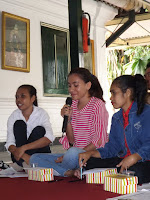Obtaining the Life Meaning from Yogyakarta Palace
Monday, 20 November 2017by adminstube
Saturday, November 18, 2017 was the day that students and activists of Stube-HEMAT Yogyakarta waited. The day gave them a chance to learn about Kraton Ngayogyakarta, history and itsrole in national struggle, education, culture and life. Siti Amirul, one of the palace tourist staffswho guided the participants to Gadri Kasatriyan explained parts of the palace, like ‘bangsal Srimanganti’ a place to wait the presence of Sultan,‘bangsal Trajumas’ a place to hear the consideration of Sultan, ‘Panitrapura’ or the administration of Kraton and ‘Prabayeksa’ or ‘kedhaton’ as the main building of the palace. Although the palace is more than 200 years old, it is still used as a residence complex of the sultan until now and listed as a world heritage building by UNESCO in 1995.
KPH Yudohadiningrat and KRT Rinto Isworo welcome the group of Stube-HEMAT Yogyakartaand opened the dialogue and expressed his delight feeling for the visit. Ariani Narwastujati, the director of Stube-HEMAT expressed her gratitude for the group of students got a permission to visit and learn about Sultan's palace. Students from various backgrounds of study, ethnics and local origin feel that Yogyakarta has a good tolerance by accepting them to study in the city, of course Kraton Yogyakarta became interesting part to be known deeper.
The initiation process of the construction of the center of Ngayogyakarta was started with ‘God’s revelation’ through Prince Mangkubumi’s dream about a holy and clean place between Mount Merapi and Parangkusumo beach, located between several rivers, namely Winongo, Bedog and Progo on the west and Code, Gajahwong and Opak on the east. When the place was found, it was a jungle called Beringan, with a small village called Pacetokan. October 9, 1755 was the beginning to open the forest and build kingdom center. The construction was completed on October 7, 1756 and began to be occupied by the royal family. The date is set as the anniversary of Yogyakarta.
In the palace environment there are palace servants who work sincerely for the palace. They wear special clothes, namely'peranakan' withheadband andpractice barefootinside the palace. This means that the servants are brothers and they are living in simplicity without discrimination even having diverse backgrounds of education, religion and age.
Answering the students' curiosity about Yogyakarta and its privileges, KPH Yudohadiningrat explainedthat governor and deputy governor must be Sultan and Paku Alam who reign at that time. The history of the privilege began in 1945, Sultanate of Yogyakarta declared to join Republic of Indonesia and President Soekarno declared Yogyakarta as a Special Region through State Law no 3/1950 and completed by State Law no 13/2012. The consequence was the change of Yogyakarta from absolute monarchy to constitutional monarchy, so the Sultan as governor adjusted the period of per five years and reappointed for the next five years.
Regarding the student's question whether the Sultanmust be a man? KPH Yudohadiningrat revealed that Sultan Hamengkubuwono X want to be an example for the community as a king or sultan who has one wife. Further, there is no Kraton literature saying thatthe king must be a man, even it is found that Sultan Hamengkubuwono V wrote 'Serat Puji' saying that 'the king of the palace should be a man but if the sultan who reigns does not have sons and there is only women, then the woman is entitled to be the king.'The main point is either man or woman who has a good figure, is able to protect and brings prosperity to the community deserves to be the king.
A visit to the Sultan's Palace brought students to discover not only the buildings and symbols but also the inheritance of life values that have continued to live till now. Students studying in Yogyakartaare expected to find the values of life andactualize it in daily life to be useful for society. (TRU).
Web Archive
2024 (6) 2013 (20)
2012 (12)
2011 (2)
2010 (18)
Total: 449


